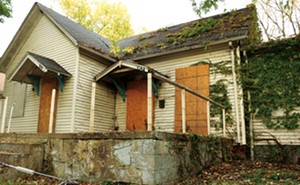
A Springfield neighborhood group may have found a little-known way to deal with abandoned properties.
Enos Park Development LLC, the real estate arm of the Enos Park Neighborhood Improvement Association, recently prevailed in two lawsuits aimed at abandoned properties. The lawsuits were filed under a state law that could offer other neighborhoods a relatively simple solution for blight while taking some of the onus off of the City of Springfield.
The lawsuits were filed in mid-August, under a section of the Illinois Municipal Code that gives property owners the right to seek legal remedies if a property within 1,200 feet – almost a quarter of a mile – of their own property is in violation of state law or local ordinances. Enos Park Development owns several properties in that neighborhood, giving the group legal standing to file lawsuits on nearby blighted properties.
One lawsuit, filed against Robert Kent Cook of Sherman, involves two properties: 1024 N. Fourth St. and 1025 N. Ninth St. Shortly after the lawsuit was filed, Cook agreed to make repairs on the properties and even joined the Enos Park Neighborhood Improvement Association.
The second lawsuit involves the house at 1154 N. Third St., owned by Paul Ayappa of Sherman and Abbas Jahanshir of Springfield. Rather than fight the lawsuit, the owners agreed to tear down the house, which is deteriorated and boarded up.
Michelle Higginbotham, president of the Enos Park Neighborhood Improvement Association, says she’s pleased with the outcome of the lawsuits and sees potential for other neighborhoods to use the same approach toward blight.
“In most cases, I think simply filing the paperwork would lead to the desired outcome,” she said. “You’re not talking about something that’s going to rack up tens of thousands of dollars in legal fees and drag on for years.”
Springfield attorney Thomas Pavlik, who represents Enos Park Development, says state law has long allowed property owners to seek legal remedies for nearby nuisance properties, but few property owners have done so.
“I don’t think people typically utilize it,” Pavlik said. “Enos Park is really in the forefront of taking ownership.”
Typically in the case of an abandoned or blighted building, city inspectors visit a property and write citations for any building code violations. The owner of the building usually must appear in administrative court, agree to fix any problems and pay a fine. However, some owners never show up or don’t fix problems with their buildings, and after enough unmitigated violations, the City of Springfield may file a lawsuit against the property owner in circuit court.
Pavlik says legal action by neighborhood groups or property owners near nuisance properties effectively relieves the City of Springfield of having to file lawsuits.
“There aren’t enough hours in the day for the city’s legal department to handle all the abandoned properties in town,” Pavlik said. “They’re doing the best they can, but the volume of this stuff is pretty big. I think it’s a good thing for folks to take ownership of their neighborhood, and this is one way that they can.”
Pavlik says Enos Park is unique because it owns property, while most other neighborhood groups in Springfield do not. However, he says, private individuals who own property can also sue owners of nuisance properties within 1,200 feet. He suggests that neighborhood groups not involved in land banking like Enos Park may want to support individual property owners by splitting legal costs related to nuisance lawsuits.
However, Pavlik cautions that plaintiffs must be ready to prove a property is a chronic nuisance. Typically, that is accomplished by citing building code violations written up by city inspectors, which means the city still has some role to play in dealing with abandoned houses.
J. Todd Greenburg, corporation counsel for the City of Springfield, says other neighborhoods following Enos Park’s lead would ease the demand on his department’s resources and manpower.
“They are very innovative,” Greenburg said. “The statute already existed – allowing people to enforce local codes – for this very reason.”
Contact Patrick Yeagle at [email protected].















